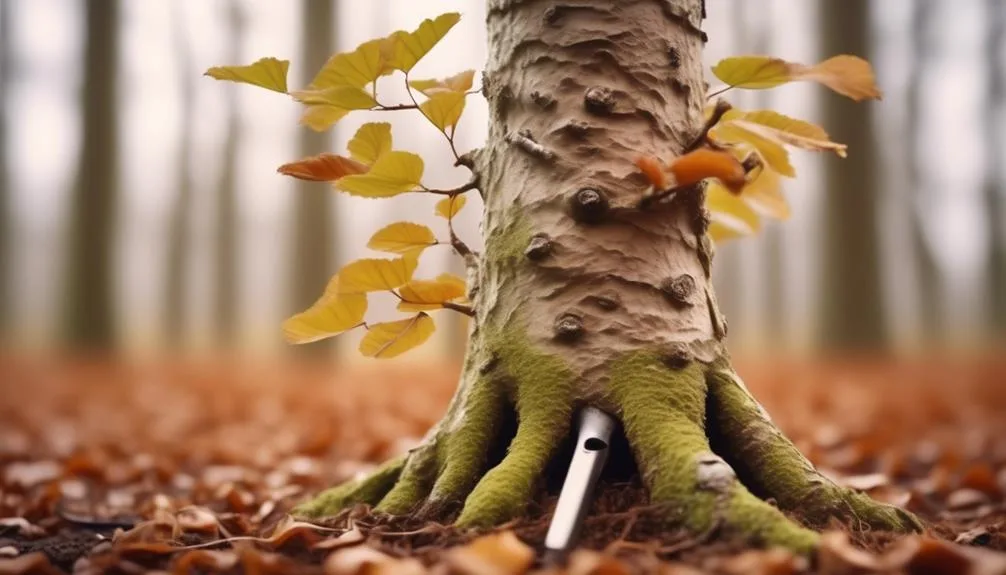Interested in adding the beauty of your neighbor's majestic beech trees to your own yard? Grafting beech trees can be a bit tricky, but the right techniques and timing make it possible.
Before diving in, consider important factors for this horticultural endeavor.
Beech Tree Grafting Basics
To successfully graft beech trees, you'll need to master the basics of this delicate horticultural art form.
Beech tree compatibility is crucial when selecting the scion (upper part) and rootstock (lower part) for grafting. Choose healthy, disease-free branches for the scion, and ensure the rootstock is compatible with the desired beech tree species.
The grafting process involves carefully joining the scion and rootstock to allow for successful union. Make precise cuts to create matching surfaces on the scion and rootstock, then secure them together using grafting tape or a similar binding material.
After the grafting is complete, provide optimal growing conditions such as consistent moisture and protection from extreme temperatures.
With patience and attention to detail, you can master the art of grafting beech trees and enjoy the beauty of customizing your tree varieties.
Suitable Grafting Techniques for Beech Trees
Consider employing a whip-and-tongue grafting technique for beech trees to ensure a secure and successful union between the scion and rootstock. This method is particularly suitable for beech trees due to their compatibility with this grafting technique.
Here's why whip-and-tongue grafting is recommended for beech trees:
- Strong Union: The whip-and-tongue graft creates maximum contact between the scion and rootstock, promoting a strong and reliable union.
- Minimized Risk of Failure: This technique minimizes the risk of graft failure, ensuring a higher success rate when grafting beech trees.
- Compatibility: Beech trees exhibit good compatibility with whip-and-tongue grafting, making it an ideal choice for ensuring successful grafting outcomes.
Best Time for Grafting Beech Trees
When grafting beech trees, the best time to carry out the process is during the dormant season, typically in late winter or early spring. This is the optimal timing as the trees aren't actively growing, which increases the chances of successful grafting. During this time, the beech tree's sap flow is minimal, allowing for better healing at the graft union.
It's crucial to ensure that the grafting partners are compatible to achieve the best results. Selecting healthy scion wood and rootstock is essential for successful grafting. Beech trees are generally compatible with various grafting partners within the same genus, such as different beech species.
Beech Tree Grafting Success Rate
Achieving a high success rate in grafting beech trees depends on careful selection of compatible grafting partners and meticulous attention to detail during the grafting process. When grafting beech trees, it's important to consider the following:
- Grafting Compatibility: Ensure that the beech tree varieties you're grafting are compatible with each other. Some varieties may have higher success rates when grafted together due to similar genetic traits.
- Proper Timing: Grafting during the dormant season when the trees aren't actively growing can increase the chances of success. This allows the graft to heal without the stress of supporting new growth.
- Rootstock Selection: Choosing healthy and vigorous rootstocks can significantly impact the success rate of the graft. Strong rootstocks provide better support for the grafted scion, leading to improved overall success rates.
Potential Challenges in Grafting Beech Trees
Facing potential challenges in grafting beech trees requires careful consideration of environmental factors and attention to detail during the grafting process. Challenges may arise due to rootstock compatibility issues, as beech trees can be finicky when it comes to forming successful unions. It's crucial to select a compatible rootstock and scion to ensure grafting success.
Beech trees also have a tendency to form reaction wood, complicating the grafting process. Additionally, their slow growth can make it difficult to achieve a strong union between the scion and rootstock. Environmental factors such as temperature and humidity can also impact grafting outcomes.
To overcome these challenges, meticulous planning, proper technique, and patience are essential. By carefully navigating these potential hurdles, you can increase the likelihood of successfully grafting beech trees.
Conclusion
In mastering the art of beech tree grafting, patience and precision are key.
By grasping the fundamentals, employing suitable techniques, and timing the process meticulously, you can achieve gratifying results.
Embracing the journey, despite its challenges, leads to the rewarding experience of successfully grafting beech trees.

My interest in trees started when I first saw the giant sequoias in Yosemite.
I was a teenager then, and I remember thinking, “I need to learn more about this.”
That moment stuck with me.
A few years later, I went on to study forestry at Michigan Tech.
Since graduating, I’ve worked in a mix of hands-on tree care and community education.
I’ve spent over ten years helping people understand how to plant, maintain, and protect the trees in their neighborhoods.
I don’t see trees as just part of the landscape.
They are living things that make a real difference in our daily lives.
